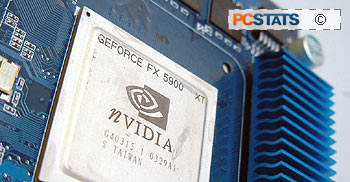
When we
removed the heatsink off the core we were greeted by a GeForceFX 5900 XT core. I
was surprised our sample was labelled wrong, nVIDIA is usually more tidy than
this.
As you
are probably already aware, nVIDIA has implemented a form of clock throttling
on their GPUs to prevent any instances of overheating. The down side to this
technology is that it certainly make overclocking a much more difficult task.... Still, we pressed
on to find out just how far the Albatron Trinity PC5900 would go.
With the core clocked at 350
MHz by default, I was hoping that the Trinity PC5900 would be able to
at least reach GeForceFX 5900/5950 Ultra speeds. To find out, the
first thing I did was boost the core speed to 400 MHz. The
next boost pushed the core of the Trinity PC5900 to 450 MHz, and things were still
running fine.... that is until I hit the "Test Settings" button. The system greeted me with a nice
blue screen. I guess I should be a bit more gentle with my overclocking huh? ;-)
After dropping the speed back down it turned out that 418 MHz was the
maximum stable speed we could run the core at. A bit disappointing, but then again
when it comes to overclocking anything above stock speeds is a bonus.
The
Trinity PC5900's Hynix 2.8ns memory is clocked at 550 MHz by default, so we inched up a few
MHz at a time towards the 600 MHz mark. In the end, the memory capped off at
582 MHz. While this isn't the best we've seen, it isn't too bad.
We were
also pleased to see that both the core and memory of the Albatron Trinity PC5900 played nicely together while overclocked. A couple other
nVIDIA videocards we've tested in the past didn't like having both core and
memory running while overclocked to the maximum frequency.
 |
| PCStats Test System Specs: |
|
system 1 |
system 2 |
| processor: |
intel pentium 4 540 |
intel pentium 4 3.0c |
| clock
speed: |
16 x 200 mhz = 3.2 ghz |
15 x 200 mhz = 3.0
ghz |
| motherboards: |
gigabyte 8anxp-d, i925x |
gigabyte 8knxp, i875p |
| videocard: |
gigabyte gv-rx60x128v
gigabyte gv-nx57128d
msi pcx5750-td128
albatron trinity pc5900 |
ati radeon 9800xt
ati radeon 9800 pro
ati
radeon 9700 pro
asus radeon 9600xt
msi fx5950 ultra-td128
msi fx5900u-vtd256
msi
fx5900xt-vtd128
aopen geforcefx
5900xt |
| memory: |
2x 256mb crucial pc4300
ddr2 |
2x 256mb corsair twinx
3200ll |
| hard
drive: |
40gb wd special
ed |
40gb wd special
ed |
| cdrom: |
msi x48 cd-rw/dvd-rom |
nec 52x cd-rom |
| powersupply: |
vantec stealth 470w |
vantec stealth 470w |
| software setup |
windowsxp build 2600
intel inf 5.02.1012
forceware 60.85 |
windowsxp build 2600
intel inf 5.02.1012
catalyst 3.9
detonator
53.03 |
| benchmarks |
3dmark2001se
codecreatures
aquamark
aquamark3
gun metal 2
x2 the
threat
ut2003
aa test, af and
aa+af test
3dmark2001se
x2 the threat
ut2003 | |
the agp
and pci-e systems are different, but the results are being included for
reference.
By
combining DirectX8 support with completely new graphics, it continues to provide
good overall system benchmarks. 3DMark2001SE has been created in cooperation
with the major 3D accelerator and processor manufacturers to provide a reliable
set of diagnostic tools. The suite demonstrates 3D gaming performance by using
real-world gaming technology to test a system's true performance abilities.
Tests include: DirectX8 Vertex Shaders, Pixel Shaders and Point Sprites, DOT3
and Environment Mapped Bump Mapping, support for Full Scene Anti-aliasing and
Texture Compression and two game tests using Ipion real-time physics.
Higher
numbers denote better performance.
The
Albatron Trinity PC5900 does fairly well here in 3DMark, considering it's a
mainstream videocard. It scores just higher than the X600XT which is pretty
good.
